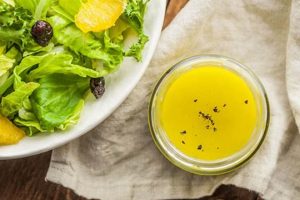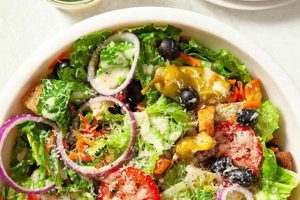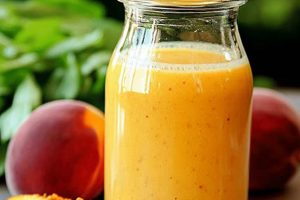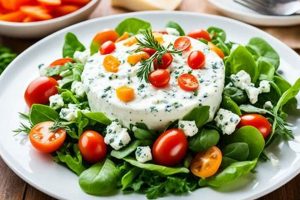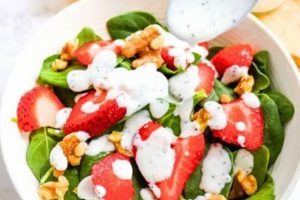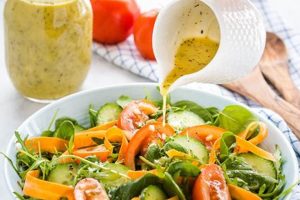Vinaigrettes based on extra virgin olive oil, nut oils, or avocado oil combined with acidic components like vinegar or citrus juice, along with herbs, spices, and other flavor enhancers provide a nutritious and lower-calorie alternative to commercially prepared dressings, many of which contain high amounts of added sugars, unhealthy fats, and artificial ingredients. For example, a simple lemon-herb vinaigrette can be made with fresh lemon juice, olive oil, minced garlic, and chopped parsley.
Controlling the ingredients and caloric density of salad dressings is crucial for individuals managing their weight. Homemade dressings allow for portion control and customization, enabling the creation of flavorful, satisfying options that align with dietary goals. Historically, salad dressings have evolved from simple oil and vinegar mixtures to more complex emulsions and creamy preparations. The increasing awareness of the impact of diet on health has led to a greater demand for healthier alternatives, emphasizing fresh, natural ingredients and reduced fat and sugar content.
This exploration will delve into various recipes for such dressings, highlighting the nutritional value of specific ingredients and offering practical tips for preparation and storage.
Tips for Creating Health-Conscious Salad Dressings
Creating flavorful, low-calorie salad dressings at home offers significant advantages for weight management. These tips provide guidance on making informed choices and maximizing nutritional benefits.
Tip 1: Embrace the Power of Vinegar. Vinegar contributes a tangy flavor and low caloric density. Experiment with different varieties, such as apple cider vinegar, red wine vinegar, or balsamic vinegar, to discover preferred flavor profiles.
Tip 2: Maximize Flavor with Herbs and Spices. Fresh or dried herbs and spices add depth and complexity to dressings without adding significant calories. Consider incorporating dill, mint, oregano, or paprika for unique taste combinations.
Tip 3: Opt for Healthy Fats. Extra virgin olive oil, avocado oil, and flaxseed oil provide beneficial monounsaturated and polyunsaturated fats. These contribute to satiety and support overall health.
Tip 4: Control Sweetness Naturally. Instead of relying on added sugars, explore natural sweeteners like a small amount of honey or maple syrup, or incorporate the sweetness of fruits like blended berries or a squeeze of orange juice.
Tip 5: Thicken Dressings Strategically. Instead of high-calorie creamy ingredients, consider using pureed avocado, Greek yogurt, or a small amount of tahini to add body and creaminess to dressings.
Tip 6: Prepare Small Batches. Making dressings in smaller quantities ensures freshness and minimizes waste, allowing for greater variety and experimentation with different flavor combinations.
Tip 7: Proper Storage is Key. Store homemade dressings in airtight containers in the refrigerator to maintain quality and prevent spoilage. Most dressings are best consumed within a week.
By following these guidelines, individuals can create flavorful and nutritious salad dressings that support weight management goals while enhancing the overall enjoyment of salads as part of a balanced diet. These practices empower individuals to make healthier choices and enjoy delicious meals without compromising flavor or dietary objectives.
Incorporating these principles facilitates a shift towards a more mindful approach to food preparation and consumption, ultimately contributing to long-term health and well-being.
1. Calorie Control
Calorie control is a cornerstone of successful weight management and a crucial consideration when selecting or preparing salad dressings. Consuming excessive calories, even from seemingly healthy foods like salads, can hinder weight loss efforts. Therefore, understanding the caloric impact of salad dressings and making informed choices is essential for achieving dietary goals.
- Oil Selection
The type of oil used significantly impacts the caloric content of a salad dressing. While healthy fats are important, they are also calorically dense. Opting for oils like extra virgin olive oil, avocado oil, or flaxseed oil in moderation provides beneficial fats without excessive calories. For example, one tablespoon of olive oil contains approximately 120 calories. Using a smaller amount or incorporating lower-calorie options like a vinegar-based dressing can contribute to calorie reduction.
- Added Sugars
Many commercially prepared salad dressings contain added sugars, which contribute to increased calorie content without providing significant nutritional value. Reading labels carefully and choosing dressings with minimal or no added sugar is crucial. Alternatively, preparing homemade dressings allows for complete control over ingredients and the exclusion of added sugars. Natural sweeteners like a small amount of honey or pure maple syrup can be used sparingly if desired.
- Portion Control
Even with healthy, low-calorie dressings, portion control remains important. Using measuring spoons or a small spray bottle helps manage the amount of dressing consumed, preventing excess calorie intake. Being mindful of portion sizes contributes to overall calorie awareness and supports weight management efforts.
- Ingredient Awareness
Certain ingredients, like nuts, seeds, cheese, and dried fruit, while nutritious, can contribute significantly to the calorie content of a salad. While these ingredients can be incorporated into salads, their portions should be considered in relation to the overall calorie goals. Balancing these additions with lower-calorie vegetables and lean protein sources ensures a balanced and calorie-conscious meal.
By carefully considering these aspects of calorie control, individuals can create and choose salad dressings that complement their weight loss objectives. A balanced approach that prioritizes nutrient-rich, lower-calorie ingredients and mindful portion sizes ensures that salads contribute to a healthy and sustainable dietary pattern.
2. Nutrient-Rich Ingredients
Nutrient-rich ingredients are fundamental to healthy salad dressing recipes that support weight loss. These ingredients not only enhance flavor but also contribute essential vitamins, minerals, antioxidants, and other beneficial compounds that support overall health and well-being. Incorporating such ingredients maximizes the nutritional value of salads, transforming them from simple meals into powerful sources of nourishment.
- Vinegar
Various vinegars, such as apple cider, balsamic, and red wine vinegar, offer distinct flavor profiles and potential health benefits. Apple cider vinegar, for example, is associated with improved insulin sensitivity and blood sugar control. Balsamic vinegar, rich in antioxidants, may contribute to cardiovascular health. The acidic nature of vinegar also aids in nutrient absorption from the accompanying salad ingredients.
- Herbs and Spices
Fresh or dried herbs and spices offer a wealth of flavor and potential health benefits. Parsley, a good source of vitamin K, supports bone health. Oregano, rich in antioxidants, may have anti-inflammatory properties. Ginger, known for its anti-nausea effects, can also aid digestion. Incorporating a variety of herbs and spices not only enhances flavor complexity but also provides a range of micronutrients.
- Citrus Fruits
Citrus fruits, such as lemons, limes, and oranges, provide a refreshing tang and a significant dose of vitamin C, a potent antioxidant. They also contain other beneficial compounds, like flavonoids, which contribute to overall health. Using fresh citrus juice in dressings provides a vibrant flavor and a boost of nutrients.
- Healthy Fats
Incorporating healthy fats in appropriate amounts is essential for nutrient absorption and satiety. Extra virgin olive oil, rich in monounsaturated fats, is linked to improved heart health. Avocado oil offers similar benefits and a creamy texture. Flaxseed oil provides omega-3 fatty acids, crucial for brain health and reducing inflammation. Using these oils in moderation ensures a balance of flavor and nutritional value.
Prioritizing nutrient-rich ingredients in salad dressings elevates their nutritional value, contributing to weight loss efforts by promoting satiety, enhancing nutrient absorption, and supporting overall health. These ingredients not only contribute to flavor complexity but also provide essential vitamins, minerals, and antioxidants that are vital for optimal well-being. By focusing on these nutrient-dense components, individuals can transform salads into truly nourishing and satisfying meals that support their weight management goals and contribute to a healthier lifestyle.
3. Portion Awareness
Portion awareness plays a critical role in the effectiveness of healthy salad dressing recipes for weight loss. Even with dressings made from wholesome, low-calorie ingredients, excessive consumption can negate the intended benefits. Calorie control, a fundamental aspect of weight management, requires careful consideration of portion sizes for all food components, including dressings. A calorie deficit, essential for weight loss, can be undermined by unknowingly consuming large portions of even healthy foods. For example, two tablespoons of a vinaigrette, while seemingly a small amount, can contribute a significant number of calories depending on the oil used. Using measuring spoons or a spray bottle to dispense dressing promotes portion control and prevents overconsumption.
Practical application of portion awareness involves not only measuring dressings but also considering the overall composition of the salad. A salad heavily laden with high-calorie toppings like cheese, nuts, or dried fruit, even with a low-calorie dressing, can be calorically dense. Balancing these additions with nutrient-rich, lower-calorie vegetables and lean protein sources ensures a balanced and calorie-conscious meal. Understanding serving sizes for different food groups contributes to informed decision-making and supports consistent portion control. Recipes for healthy salad dressings often include portion recommendations per serving, emphasizing the importance of adhering to these guidelines for optimal results.
Challenges in maintaining portion awareness can arise from dining out, where portion sizes are often larger than recommended serving sizes. Requesting dressing on the side allows for individual control over the amount used. Similarly, pre-portioned snacks and meals at home contribute to consistent adherence to portion guidelines. Ultimately, cultivating portion awareness empowers individuals to manage calorie intake effectively, maximizing the benefits of healthy salad dressing recipes and supporting sustainable weight management goals.
4. Flavorful Variety
Flavorful variety is essential for adherence to any dietary plan, especially those focused on weight loss. Monotony in meals can lead to diet fatigue and increase the likelihood of abandoning healthy eating habits. Offering a diverse range of flavors in salad dressings keeps meals interesting and satisfying, promoting long-term adherence to weight management goals.
- Exploring Global Cuisines
Drawing inspiration from diverse culinary traditions offers a wide spectrum of flavor profiles. A Japanese-inspired dressing might incorporate ginger, soy sauce, and rice vinegar, while a Mediterranean dressing could feature lemon, oregano, and garlic. This exploration exposes individuals to new taste combinations and prevents boredom with meal choices.
- Seasonal Ingredient Integration
Utilizing seasonal ingredients not only maximizes freshness and flavor but also provides variety throughout the year. A spring dressing might feature fresh herbs like mint and dill, while a fall dressing could incorporate roasted butternut squash or apple cider. This seasonal approach ensures a constantly evolving flavor profile and aligns with the natural availability of ingredients.
- Balancing Taste Profiles
Creating a balance of sweet, sour, salty, and savory notes within a dressing enhances complexity and satisfaction. Balancing the acidity of vinegar with the sweetness of fruit or the richness of a nut oil creates a more nuanced and enjoyable flavor experience. This balance prevents any single flavor from dominating and contributes to a more well-rounded taste.
- Textural Variation
Incorporating ingredients that provide textural contrast adds another dimension to flavorful variety. Toasted nuts, seeds, or finely diced vegetables offer a satisfying crunch, while blended fruits or pureed avocado contribute creaminess. These textural variations create a more dynamic and engaging sensory experience, further enhancing enjoyment and preventing mealtime monotony.
By embracing flavorful variety in healthy salad dressing recipes, individuals can maintain enjoyment and adherence to weight loss plans. The exploration of diverse culinary influences, seasonal ingredients, balanced taste profiles, and textural variations ensures a continuously engaging and satisfying culinary experience, supporting long-term dietary success and promoting a positive relationship with healthy eating.
5. Homemade Preparation
Homemade preparation of salad dressings offers significant advantages for individuals seeking healthy weight loss strategies. Control over ingredients, customization options, and cost-effectiveness are key benefits that distinguish homemade dressings from commercially produced alternatives. This control empowers individuals to align their dietary choices with weight management goals and create dressings tailored to individual preferences and health needs.
- Ingredient Control
Homemade preparation grants complete control over the quality and quantity of ingredients used in salad dressings. This allows for the exclusion of unhealthy additives like excessive sodium, added sugars, and artificial flavors often found in commercial products. Selecting fresh, whole ingredients like high-quality oils, vinegars, herbs, and spices ensures that the dressing contributes to, rather than detracts from, a healthy diet. For instance, using extra virgin olive oil instead of refined vegetable oil provides beneficial monounsaturated fats and antioxidants. This control allows for customization based on dietary restrictions or preferences, such as using low-sodium soy sauce or omitting certain allergens.
- Customization Options
Homemade dressings offer flexibility in tailoring flavors to individual preferences. Experimenting with different herbs, spices, citrus fruits, and vinegars allows for the creation of unique flavor profiles that enhance enjoyment and prevent dietary monotony. This customization extends to texture as well, with options to create creamy dressings using ingredients like avocado or Greek yogurt, or thinner vinaigrettes based on oil and vinegar. This adaptability ensures that salads remain appealing and contribute to a sustainable, long-term healthy eating pattern.
- Cost-Effectiveness
Preparing salad dressings at home is generally more economical than purchasing pre-made options. Many common ingredients, like oil, vinegar, and spices, are pantry staples, reducing the need for frequent grocery purchases. Making larger batches of dressing and storing them properly can further reduce costs over time. This cost-effectiveness makes healthy eating more accessible and sustainable, particularly for those on a budget.
- Freshness and Quality
Homemade dressings offer the advantage of freshness. Using fresh ingredients maximizes flavor and nutritional value, avoiding the preservatives and stabilizers often found in commercial products. This freshness enhances the overall sensory experience of the meal and ensures that the dressing contributes to, rather than detracts from, the nutritional benefits of the salad. Preparing smaller batches as needed further maximizes freshness and minimizes waste.
By prioritizing homemade preparation, individuals gain control over ingredients, customize flavors, reduce costs, and ensure freshness, all of which contribute to the effectiveness of healthy salad dressing recipes for weight loss. This practice empowers individuals to make informed choices that align with their dietary goals and promote a sustainable, healthy lifestyle. The ability to tailor dressings to individual needs and preferences further enhances adherence to long-term dietary changes, making weight management a more achievable and enjoyable process.
Frequently Asked Questions
This section addresses common inquiries regarding the role of healthy salad dressings in weight management strategies. Clarity on these points can facilitate informed decision-making and support effective dietary choices.
Question 1: How can salad dressings contribute to weight gain?
Commercially prepared dressings often contain high levels of added sugars, unhealthy fats, and excessive sodium, contributing to increased calorie intake and potential weight gain. Hidden sugars and unhealthy fats can negate the health benefits of consuming a salad.
Question 2: What are the healthiest oils for homemade salad dressings?
Extra virgin olive oil, avocado oil, and flaxseed oil are excellent choices due to their high content of monounsaturated and polyunsaturated fats, which offer various health benefits. These oils should be used in moderation due to their caloric density.
Question 3: How can one make creamy dressings without excessive calories?
Ingredients like blended avocado, Greek yogurt, or tahini can create a creamy texture without resorting to high-calorie mayonnaise or sour cream. These alternatives offer healthy fats, protein, and other nutrients.
Question 4: What are some strategies for reducing sodium in salad dressings?
Using fresh herbs, spices, lemon juice, and low-sodium or no-salt-added ingredients minimizes sodium intake. Commercial dressings often contain high levels of sodium, which can contribute to health issues.
Question 5: How long can homemade salad dressings be stored?
Most homemade dressings can be stored in airtight containers in the refrigerator for up to one week. Proper storage maintains quality and prevents spoilage. Discarding dressings after one week minimizes the risk of foodborne illness.
Question 6: Are all store-bought dressings unhealthy for weight loss?
Not all store-bought dressings are detrimental to weight loss. Carefully examining nutrition labels for added sugars, unhealthy fats, and sodium content helps identify healthier choices. Opting for vinaigrettes or dressings with minimal processing and natural ingredients is generally recommended.
Understanding the composition of salad dressings and making informed choices supports healthy weight management. Prioritizing fresh, whole ingredients and portion control ensures that salads contribute to a balanced and nutritious diet.
The subsequent section will provide a collection of specific healthy salad dressing recipes suitable for weight loss.
Healthy Salad Dressing Recipes for Weight Loss
Exploration of healthy salad dressing recipes for weight loss reveals the significant impact dietary choices have on weight management efforts. Prioritizing homemade preparations using fresh, nutrient-rich ingredients empowers individuals to control calorie intake, sodium levels, and added sugar consumption. Utilizing a variety of flavorful herbs, spices, and vinegars promotes dietary adherence by preventing mealtime monotony. Portion awareness remains crucial, even with healthy ingredients, to maintain a calorie deficit conducive to weight loss. Careful consideration of oil choices, emphasizing those rich in monounsaturated and polyunsaturated fats, further contributes to overall health and well-being.
The integration of these principles into daily dietary practices offers a sustainable approach to weight management. Shifting focus from commercially produced dressings, often laden with unhealthy additives, to homemade alternatives allows individuals to actively participate in their health journey. This mindful approach to food preparation not only supports weight loss goals but also cultivates a deeper understanding of the nutritional value of food choices, fostering a long-term commitment to a healthier lifestyle.

